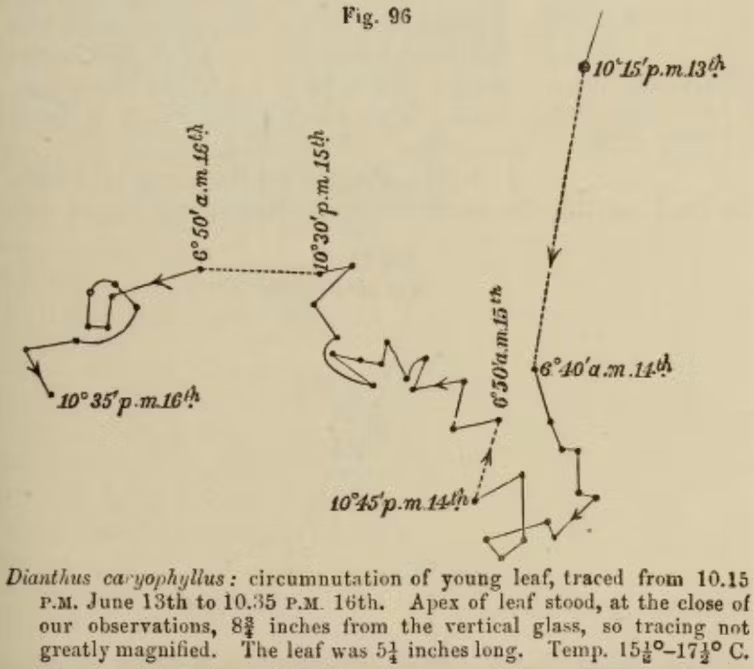Most of us aren’t spending our days watching our houseplants grow. We see their signs of life only occasionally – a new leaf unfurled, a stem leaning toward the window.
But in the summer of 1863, Charles Darwin lay ill in bed, with nothing to do but watch his plants so closely that he could detect their small movements to and fro. The tendrils from his cucumber plants swept in circles until they encountered a stick, which they proceeded to twine around.
“I am getting very much amused by my tendrils,” he wrote.
This amusement blossomed into a decadeslong fascination with the little-noticed world of plant movements. He compiled his detailed observations and experiments in a 1880 book called “The Power of Movement in Plants.”

A diagram tracking the circumnutation of a leaf over three days.
Charles Darwin
In one study, he traced the motion of a carnation leaf every few hours over the course of three days, revealing an irregular looping, jagged path. The swoops of cucumber tendrils and the zags of carnation leaves are examples of inherent, ubiquitous plant movements called circumnutations – from the Latin circum, meaning circle, and nutare, meaning to nod.
Circumnutations vary in size, regularity and timescale across plant species. But their exact function remains unclear.
I’m a physicist interested in understanding collective behavior in living systems. Like Darwin, I’m captivated by circumnutations, since they may underlie more complex phenomena in groups of plants.
Sunflower patterns
A 2017 study revealed a fascinating observation that got my colleagues and me wondering about the role circumnutations could play in plant growth patterns. In this study, researchers found that sunflowers grown in a dense row naturally formed a near-perfect zigzag pattern, with each plant leaning away from the row in alternating directions.
This pattern allowed the plants to avoid shade from their neighbors and maximize their exposure to sunlight. These sunflowers flourished.
Researchers then planted some plants at the same density but constrained them so that they could grow only upright without leaning. These constrained plants produced less oil than the plants that could lean and get the maximum amount of Sun.
While farmers can’t grow their sunflowers quite this close together due to the potential for disease spread, in the future they may be able to use these patterns to come up with new planting strategies.
Self-organization and randomness
This spontaneous pattern formation is a neat example of self-organization in nature. Self-organization refers to when initially disordered systems, such as a jungle of plants or a swarm of bees, achieve order without anything controlling them. Order emerges from the interactions between individual members of the system and their interactions with the environment.
Somewhat counterintuitively, noise – also called randomness – facilitates…



